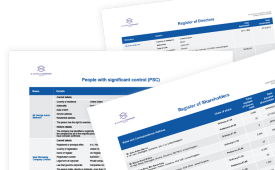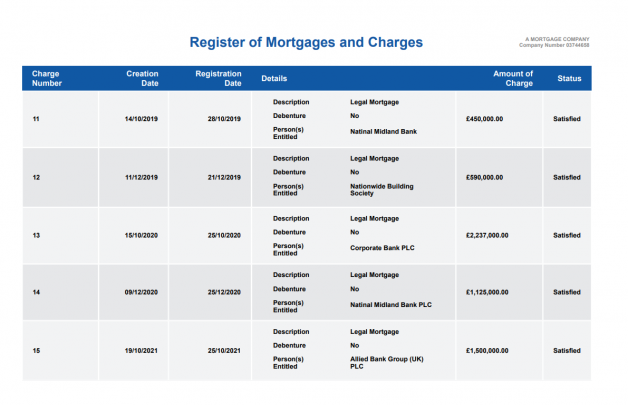Keeping a register of mortgages and charges helps a company keep track of its current obligations. This makes it easier to give quick answers to queries arising from audit or other third parties. Keeping a mortgages and charges register is particularly advisable for medium to large companies with multiple charges to manage. The charges register is an internal document and should not be confused with the public record maintained by Companies House.
Following implementation of The Companies Act 2006 (Amendment of Part 25) Regulations 2013, charges must now be registered with Companies House for inclusion on the public record. Keeping an internal mortgages and charges register can simplify this process, since all the information is already to hand. For further details on keeping the public register up to date, refer to our guide on registering a charge at Companies House.
The quick and simple way to register a charge
File your form MR01 electronically using our simple step by step process.
Here we are focusing on the internal, non-statutory company document which a company can choose to maintain but which does not itself need to be filed at Companies House (though the mortgages and charges do).
What details does the register of mortgages and charges contain?
There is no statutory guidance as to the details that should be included when a company decides to maintain this register internally. However, a register of mortgages and charges would normally include some or all of the following details:
1 Charge code
The charge code is a number allocated to the charge by Companies House when they register it for inclusion on the public record.
If the charge was registered before April 2013 the charge code allocated would have been given a simple sequential number, such as ‘1’, ‘2’, ‘3’, etc.
Charges registered with Companies House since April 2013 are allocated a charge code that is constructed from the company number plus ‘000’ followed by a sequential number. For example, ‘081238560001’ followed by ‘081238560002’ for the subsequent charge.
The charge code can be found on the certificate of registration issued by Companies House when they register a charge.
2 Creation date
This is the date that the original written instrument was created. It may be:
- the date the charge came into effect;
- the date of delivery of the deed;
- the date of execution or the date recorded in the Register of Sasines or Land Register of Scotland.
3 Registration date
This is the date the charge was registered with Companies House.
4 Details of the mortgage or charge
This would normally entail a brief description of the nature of the charge. For example, ‘Mortgage’, ‘Debenture’, ‘Legal charge’ or ‘Assignment by way of security’.
5 Person(s) entitled to the charge/chargee or mortgagee
The chargee name refers to the name of the person(s) or institution(s) in whose favour the charge is drawn up (i.e. the lender).
6 Amount of charge
The amount covered by the written instrument or charge document.
7 The status of the charge
A short description to indicate the current status of the charge. For example, ‘Outstanding’, ‘Satisfied’, ‘Released’, ‘Part satisfied’ or ‘Part released’.
A register of mortgages and charges which can be produced free using Inform Direct online company secretarial software is shown below.
When the directors do decide to maintain a charges register, this should be kept with the other registers. The location for the registers is usually the company’s registered office address. It is possible to hold the register of mortgages and charges and other registers at an alternative location, known as the Single Alternative Inspection Location (SAIL). This alternative address must be reported to Companies House.
Who normally looks after the register of mortgages and charges?
Maintenance of the charges register is a task that normally falls to the company secretary. If the company has not appointed anyone to this role, it falls to the directors or finance officer. Most companies have few mortgages and charges, and these usually represent medium to longer term commitments that do not change frequently. However, for companies with multiple mortgages and charges, keeping an up-to-date register is essential for effective internal administration.
Some companies may consider outsourcing this task, but the costs of doing so can be considerable. Using company secretarial software like Inform Direct can reduce the workload. The system automatically updates the charges register each time a new charge is added or any changes are made to an existing charge. Costs are also kept as low as possible.
When should the register of mortgages and charges be updated?
There is no statutory requirement to maintain an up-to-date charges register. However, for effective internal housekeeping it should be updated in each of the following circumstances:
- Registration of a new charge
- Part-release of an existing mortgage or charge
- Part-satisfaction of an existing mortgage or charge
- Full release of an existing mortgage or charge
- Full satisfaction of an existing mortgage or charge
- Change of details for an existing mortgage or charge.
Inform Direct makes it easy to keep your charges register up to date for all of the above changes. Each time you use Inform Direct to report the change to Companies House, the system automatically updates your register of mortgages and charges. The register is synchronised with details held by Companies House and will automatically include the details of all charges held on the public record.
You can also manually add the details of historic mortgages created and satisfied or released before 1st January 1987. That was when Companies House started to maintain a public record of these details.
What mortgage and charge details must a company keep by law?
Following changes that came into effect on 6th April 2013, companies are no longer required to maintain a charges register. However, Part 25 of the Companies Act 2006 does require companies to keep important charge-related documents available for inspection at the registered office or SAIL address:
Part 25, Section 859P Companies Act 2006: Companies to keep copies of instruments creating and amending charges
A company must keep available for inspection a copy of every:
- Written instrument or document creating a charge capable of registration under Part 25 of the Companies Act 2006
- Written instrument or document effecting any amendment or variation of a charge
- Other documents referred to in or incorporated into an instrument, that contains details of the particulars of the charge as outlined in section 859D (1) of the Companies Act 2006.
Note that if the charge is included in a series of identical debentures, the regulations require the company to keep a copy of only one of the debentures in the series available for inspection.
This article was originally published in December 2018. It was updated, revised and checked for accuracy and relevance on 18 August 2022.


